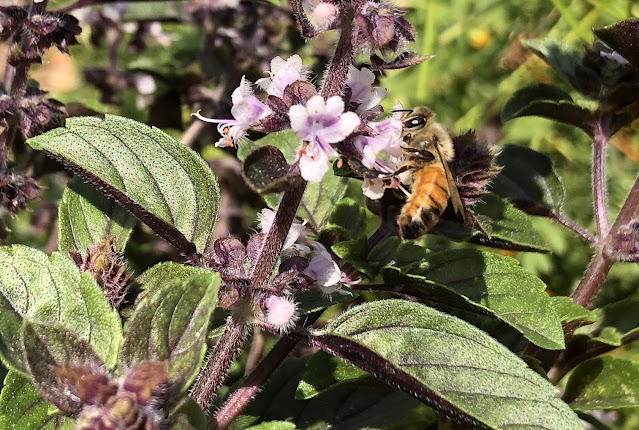
Take an active role in celebrating Pollinator Week

|
|
A honeybee lingers on a pollinator's flowering favorite: African blue basil. (Photo:
Kathy Morrison)
|
I never get tired of watching pollinators in action. The carpenter bees bending the branches of the "Hot Lips" salvia as they dig into the blossoms, the Anna's hummingbirds swooping into backyard to sample the hyssop, the fiery skipper butterflies landing delicately on matching orange zinnias.
And of course all those hard-working honeybees wiggling around in the squash flowers, producing more zucchini than I can eat. It's a busy world, the pollinator world, and we owe it thanks and assistance.
The Pollinator Partnership notes that about 75% of all flowering plants rely on animal pollinators and over 200,000 species of animals act as pollinators. Of those, about 1,000 are hummingbirds, bats, and small mammals. The rest are insects such as beetles, flies, bees, ants, wasps, butterflies, and moths.
Pollinator Week is an annual celebration in support of pollinator health that was initiated and is managed by Pollinator Partnership. Here is the PP's list of suggestions for gardeners who wish to have a pollinator-friendly garden (and who wouldn't?):
• Design your garden so that there is a continuous succession of plants flowering from spring through fall. Check for the species or cultivars best suited to your area and gradually replace lawn grass with flower beds.Some side notes from me on pollinators:
-- Remember that pollinators such as bees avoid extreme heat, too. During a heat spike, that means vine crops such as squash or melons are not getting pollinated. Take on a pollinator role yourself: Grab a watercolor brush or even a cotton swab and move pollen from the male flower (skinny stalk) to the female flower (tiny squash visible under the flower).
-- Don't deadhead every plant in your garden. Let some of them, especially the herbs, flower for the pollinators to enjoy. Chamomile, basil, parsley and cilantro flowers are some pollinator favorites.
-- Support the UC Davis Bee Haven . This wonderful outdoor museum and educational resource exists entirely on donations and volunteer work.
Comments
0 comments have been posted.Sacramento Digs Gardening to your inbox.
Sites We Like
Garden Checklist for week of April 21
This week there’s plenty to keep gardeners busy. With no rain in the immediate forecast, remember to irrigate any new transplants.
* Weed, weed, weed! Get them before they flower and go to seed.
* April is the last chance to plant citrus trees such as dwarf orange, lemon and kumquat. These trees also look good in landscaping and provide fresh fruit in winter.
* Smell orange blossoms? Feed citrus trees with a low dose of balanced fertilizer (such as 10-10-10) during bloom to help set fruit. Keep an eye out for ants.
* Apply slow-release fertilizer to the lawn.
* Thoroughly clean debris from the bottom of outdoor ponds or fountains.
* Spring brings a flush of rapid growth, and that means your garden is really hungry. Feed shrubs and trees with a slow-release fertilizer. Or mulch with a 1-inch layer of compost.
* Azaleas and camellias looking a little yellow? If leaves are turning yellow between the veins, give them a boost with chelated iron.
* Trim dead flowers but not leaves from spring-flowering bulbs such as daffodils and tulips. Those leaves gather energy to create next year's flowers. Also, give the bulbs a fertilizer boost after bloom.
* Pinch chrysanthemums back to 12 inches for fall flowers. Cut old stems to the ground.
* Mulch around plants to conserve moisture and control weeds.
* From seed, plant beans, beets, cantaloupes, carrots, corn, cucumbers, melons, radishes and squash.
* Plant onion sets.
* In the flower garden, plant seeds for asters, cosmos, celosia, marigolds, salvia, sunflowers and zinnias.
* Transplant petunias, zinnias, geraniums and other summer bloomers.
* Plant perennials and dahlia tubers for summer bloom.
* Mid to late April is about the last chance to plant summer bulbs, such as gladiolus and tuberous begonias.
* Transplant lettuce seedlings. Choose varieties that mature quickly such as loose leaf.